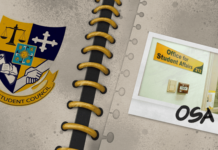THE PROOF of the pudding is in the eating.
Dr. Gloria Bernas, Office of Research and Development (ORD) director and assistant to the Rector for Research and Development, said she was well aware of the rumors about the TARC’s inefficacy but is confident that its performance will settle these speculations once and for all.
The SRC’s “Res Socialis”, which tackles three major issues of the society—poverty, environmental degradation, and economics—is scheduled to be published within the first semester of the school year.
Another upcoming research, in cooperation with the London School of Economics, is the “Unified Model on Sustainable Development,” which will create an ideal model for the development for the society and the economy.
Meanwhile, CIS Director Dr. Cynthia Rivera, looking toward another productive year, said she is following the success of Faculty of Arts and Letters professor and CIS researcher Erlita Mendoza’s book, “A Cofradia of Two.”
CIS research books, namely “Santa Clara/Kyrial,” “Dadong,” “Nacio Fallecio: The Art and Architecture of Spanish-Colonial Baptistery and Cemeteries in the Philippines,” “American Colonial Architecture,” “Sinakulo,” “C.M. Recto,” and “UST Encyclopedia for the Arts” will also be launched this school year.
Meanwhile, The Material Science and Chemical Engineering laboratory is studying Plant-based materials that can be used as alternative fuel for diesel engines. The poster of the study will be presented this June to the Philippine American Academy of Science and Engineering, the institution that oversees these researches, while the paper will be presented to the Philippine Association of Technology and Engineering this November.
The Food Research Laboratory, meanwhile, is determining whether the “French Paradox” is applicable to the Philippines. The French Paradox is anirony involving a majority of French people who generally eat fatty-foods yet do not suffer heart ailments due to the consumption of red wine, a beverage that was discovered to have anti-oxidant properties, which greatly reduces the risk of heart ailments, said researcher Elisabeth Hashim.
“Some local wines, like Bignay and Duhat have the same anti-oxidant properties similar to French wine,” Hashim said.
Further, the Pharmacology laboratory is conducting a research for smooth muscle activity while the Microbiology laboratory is looking to create anti-bacterial and anti-fungal medicine from certain species of lactobacillus. Both researches are expected to be published in the middle of the year.
Also, the Pharmacology laboratory began studying plant extracts that are potentially anti-spasmodic. So far 13 out of 34 plants gave positive results.
Meanwhile, the Center for Research on Movement Sciences’ (CRMS) latest study is on the fitness program of the AFP. Apparently, some soldiers could not tolerate the exercises being administered and, as a result, were severely injured. It has also completed a study on the content of a new local energy drink.
Bernas herself is still studying cancer cells and has recently discovered that wild yellow ginger is a good anti-inflammatory and anti-oxidizing agent.
In addition, the Science and Technology flagship has published the UST collection for Microbial Stains and the Guidebook to Plant screening: Phytochemical and Biological. Jordan Mari S. De Leon











what are the examples of biological stains? can duhat be use to be a biological stain ?thanks!
Bought this particular as a present to the mama as well as she loved it. pleasant quality good pricing and also my mother enjoyed they. In addition delivered ultra fast. So if you require a gift fast and you such as this versus this is basically the one one should go for!